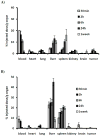Geometry and surface characteristics of gold nanoparticles influence their biodistribution and uptake by macrophages
- PMID: 21093587
- PMCID: PMC3379889
- DOI: 10.1016/j.ejpb.2010.11.010
Geometry and surface characteristics of gold nanoparticles influence their biodistribution and uptake by macrophages
Abstract
Spherical and rod-shaped gold nanoparticles with surface poly(ethylene glycol) (PEG) chains were characterized for size, shape, charge, poly dispersity and surface plasmon resonance. The nanoparticles were injected intravenously to 6-8-week-old female nu/nu mice bearing orthotopic ovarian tumors, and their biodistribution in vital organs was compared. Gold nanorods were taken up to a lesser extent by the liver, had longer circulation time in the blood, and higher accumulation in the tumors, compared with their spherical counterparts. The cellular uptake of PEGylated gold nanoparticles by a murine macrophage-like cell line as a function of geometry was examined. Compared to nanospheres, PEGylated gold nanorods were taken up to a lesser extent by macrophages. These studies point to the importance of gold nanoparticle geometry and surface properties on transport across biological barriers.
Copyright © 2010 Elsevier B.V. All rights reserved.
Figures






Similar articles
-
In vivo comparison of the biodistribution and long-term fate of colloids - gold nanoprisms and nanorods - with minimum surface modification.Nanomedicine (Lond). 2019 Dec;14(23):3035-3055. doi: 10.2217/nnm-2019-0253. Epub 2019 Nov 5. Nanomedicine (Lond). 2019. PMID: 31686580
-
Biodistribution of colloidal gold nanoparticles after intravenous injection: Effects of PEGylation at the same particle size.Biomed Mater Eng. 2018;29(2):205-215. doi: 10.3233/BME-171723. Biomed Mater Eng. 2018. PMID: 29457594
-
Cellular uptake and toxicity of gold nanoparticles in prostate cancer cells: a comparative study of rods and spheres.J Appl Toxicol. 2010 Apr;30(3):212-7. doi: 10.1002/jat.1486. J Appl Toxicol. 2010. PMID: 19902477
-
Critical parameters in the pegylation of gold nanoshells for biomedical applications: an in vitro macrophage study.J Drug Target. 2009 Apr;17(3):181-93. doi: 10.1080/10611860802582442. J Drug Target. 2009. PMID: 19016072
-
Advances in biodistribution of gold nanoparticles: the influence of size, surface charge, and route of administration.Biomed Mater. 2024 Jun 21;19(4). doi: 10.1088/1748-605X/ad5484. Biomed Mater. 2024. PMID: 38838693 Review.
Cited by
-
Nucleic acid nanostructures for in vivo applications: The influence of morphology on biological fate.Appl Phys Rev. 2023 Mar;10(1):011304. doi: 10.1063/5.0121820. Appl Phys Rev. 2023. PMID: 36874908 Free PMC article. Review.
-
Pharmacokinetics of magnetic iron oxide nanoparticles for medical applications.J Nanobiotechnology. 2022 Jun 27;20(1):305. doi: 10.1186/s12951-022-01510-w. J Nanobiotechnology. 2022. PMID: 35761279 Free PMC article. Review.
-
Peanut-Shaped Gold Nanoparticles with Shells of Ceragenin CSA-131 Display the Ability to Inhibit Ovarian Cancer Growth In Vitro and in a Tumor Xenograft Model.Cancers (Basel). 2021 Oct 29;13(21):5424. doi: 10.3390/cancers13215424. Cancers (Basel). 2021. PMID: 34771587 Free PMC article.
-
Recombinant Synthesis of Hybrid Lipid-Peptide Polymer Fusions that Self-Assemble and Encapsulate Hydrophobic Drugs.Angew Chem Int Ed Engl. 2017 Nov 6;56(45):13979-13984. doi: 10.1002/anie.201704625. Epub 2017 Oct 9. Angew Chem Int Ed Engl. 2017. PMID: 28879687 Free PMC article.
-
Long-Term Accumulation, Biological Effects and Toxicity of BSA-Coated Gold Nanoparticles in the Mouse Liver, Spleen, and Kidneys.Int J Nanomedicine. 2024 May 8;19:4103-4120. doi: 10.2147/IJN.S443168. eCollection 2024. Int J Nanomedicine. 2024. PMID: 38736658 Free PMC article.
References
-
- Choi Y, Baker LA, Hillebrenner H, Martin CR. Biosensing with conically shaped nanopores and nanotubes. Phys Chem Chem Phys. 2006;8:4976–4988. - PubMed
-
- Giri S, Trewyn BG, Stellmaker MP, Lin VSY. Stimuli-responsive controlled- release delivery system based on mesoporous silica nanorods capped with magnetic nanoparticles. Angew Chem Int Edn. 2005;44:5038–5044. - PubMed
-
- Ferrari M. Cancer nanotechnology: opportunities and challenges. Nat Rev Cancer. 2005;5:161–171. - PubMed
-
- Chen J, Wiley B, Li ZY, Campbell D, Saeki F, Cang H, Au L, Lee J, Li X, Xia Y. Gold nanocages; engineering their structure for biomedical applications. Adv Mater. 2005;17:2255–2261.
Publication types
MeSH terms
Substances
Grants and funding
LinkOut - more resources
Full Text Sources
Other Literature Sources
Research Materials

